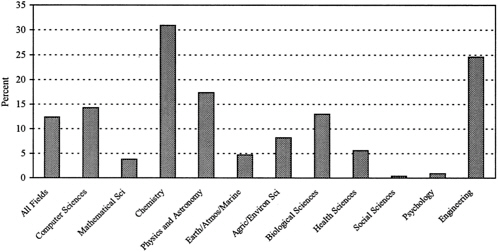Papers
-
Seventy-three percent of science and engineering Ph.D.s had authored or co-authored papers for presentation at regional, national, or international conferences between April 1990 and April 1995. The mean number of papers presented was 6.4 overall (see Table 35 ).
-
Variances in the number of papers produced for conferences by field, sector, academic position, and tenure status were similar to those in the number of articles published (see above). An exception was that doctorates in computer and earth/atmospheric/marine sciences were most likely to have authored a conference paper (86 and 85 percent, respectively).
Patents
-
The productivity of science and engineering doctorates can also be examined by looking at the number of patent applications on which they were named, the number of patents granted, and the number of patents that were commercialized. Overall, 12 percent said they had been named as an inventor on a patent application between April 1990 and April 1995 (see Table 37 ).
-
The number of times science and engineering doctorates were named as an inventor on a patent varied by field. Almost no social science or psychology Ph.D.s were named as an inventor on a patent application (less than 1 percent for each). Other fields with a low percentage of doctorates named as inventor included mathematical sciences (4 percent), earth/atmospheric/marine sciences (5 percent), health sciences (6 percent), and agricultural/environmental sciences (8 percent). Those fields with a high percentage named on a patent application were chemistry (31 percent) and engineering (25 percent).
-
Of those who had been named as an inventor on a patent application between April 1990 and April 1995, 59 percent had been named on 1 to 2 patent applications, 36 percent on 3 to 10 applications, and 5 percent had been named on 10 or more. However, 30 percent had no patents granted, while 46 percent had 1 to 2 granted, 21 percent had 3 to 10 granted, and 4 percent had 10 or more granted. Ph.D.s in chemistry and physics/astronomy had the highest rates of success in obtaining patents (79 and 78 percent, respectively), followed by engineering doctorates (72 percent).
-
An interesting follow-on question is whether the patents granted resulted in commercialized products or processes or were licensed. Overall, 52 percent of those granted patents said that their patents had been licensed or commercialized. Thirteen percent of all those who had been granted a patent indicated that more than 2 of their patents had been commercialized or licensed.



